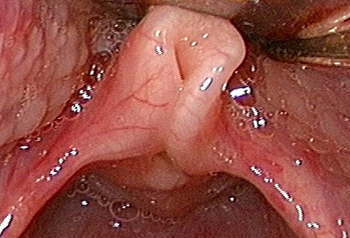Summary
Definition
History and exam
Key diagnostic factors
- stridor
- onset within 2 weeks of birth
- features of airway obstruction
- resolution of symptoms by 2 years of age
- normal cry
Other diagnostic factors
- feeding difficulties
- weight loss or failure to thrive
- hypotonia
- dysmorphic features
Risk factors
- GERD
- neurologic abnormalities
- laryngeal anatomic abnormalities
- male sex
- genetic syndromic disorder
Diagnostic tests
1st tests to order
- flexible laryngoscopy
Tests to consider
- rigid laryngobronchoscopy
- FEES testing
- polysomnography
- chest x-ray
- lateral neck radiograph
- ECG
- echocardiogram
Treatment algorithm
mild disease
moderate disease
severe disease
Contributors
Authors
Simone J. Boardman, MBBS, FRACS (OHNS)
Consultant Paediatric Otolaryngologist
The Children's Hospital at Westmead
Sydney
Australia
Disclosures
SJB declares that she has no competing interests.
Acknowledgements
Dr Simone Boardman would like to gratefully acknowledge Mr C. Martin Bailey, a previous contributor to this topic.
Disclosures
CMB is an author of a number of references cited in this topic.
Peer reviewers
Kevin Pereira, MD
Director
Pediatric Otolaryngology-HNS
University of Maryland School of Medicine
Baltimore
MD
Declarações
KP declares that he has no competing interests.
Haytham Kubba, FRCS
Consultant Paediatric Otolaryngologist
Royal Hospital for Sick Children (Yorkhill)
Glasgow
UK
Declarações
HK declares that he has no competing interests.
Gresham Richter, MD
Assistant Professor
Associate Residency Program Director
Otolaryngology - Head and Neck Surgery
University of Arkansas for Medical Sciences
Little Rock
AR
Declarações
GR declares that he has no competing interests.
Créditos aos pareceristas
Os tópicos do BMJ Best Practice são constantemente atualizados, seguindo os desenvolvimentos das evidências e das diretrizes. Os pareceristas aqui listados revisaram o conteúdo pelo menos uma vez durante a história do tópico.
Declarações
As afiliações e declarações dos pareceristas referem--se ao momento da revisão.
Referências
Principais artigos
Olney DR, Greinwald JH Jr, Smith RJ, et al. Laryngomalacia and its treatment. Laryngoscope. 1999 Nov;109(11):1770-5. Resumo
Carter J, Rahbar R, Brigger M, et al. International Pediatric ORL Group (IPOG) laryngomalacia consensus recommendations. Int J Pediatr Otorhinolaryngol. 2016 Jul;86:256-61. Resumo
McCaffer C, Blackmore K, Flood LM. Laryngomalacia: is there an evidence base for management? J Laryngol Otol. 2017 Nov;131(11):946-54. Resumo
Yellon RF, Goldberg H. Update on gastroesophageal reflux disease in pediatric airway disorders. Am J Med. 2001 Dec 3;111(suppl 8A):78S-84S. Resumo
Artigos de referência
Uma lista completa das fontes referenciadas neste tópico está disponível para os usuários com acesso total ao BMJ Best Practice.

Diagnósticos diferenciais
- Vocal cord palsy
- Subglottic stenosis
- Laryngeal web
Mais Diagnósticos diferenciaisDiretrizes
- Laryngomalacia consensus recommendations
- New Zealand guidelines for the assessment of sleep-disordered breathing in childhood
Mais DiretrizesFolhetos informativos para os pacientes
Reflux in infants
Mais Folhetos informativos para os pacientesConectar-se ou assinar para acessar todo o BMJ Best Practice
O uso deste conteúdo está sujeito ao nosso aviso legal